Online activities
Online teens, particularly older ones, are omnivorous Web users. They sample a large variety of activities online. They particularly resemble the adult newcomers to the Internet that we named “Instant Acolytes” in the fall of 2000.16 Instant Acolytes and teens of all experience levels alike are enthusiastic Internet users, embracing the entertainment and communication aspects of the Internet, and expressing less concern about potential dangers online. Neither group is very likely to have transacted anything online. Among teens, it is likely that the lack of spending is tied to their limited access to credit cards.
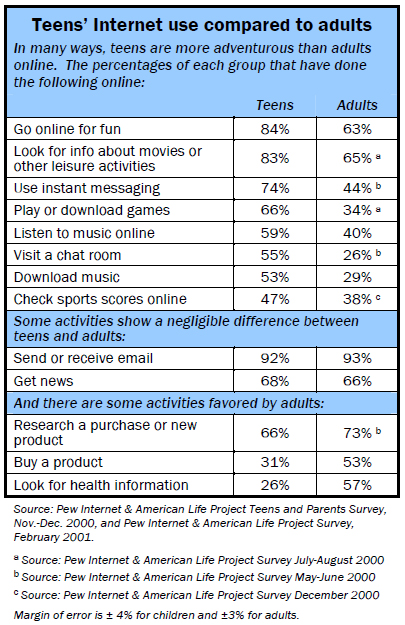
Online activities
Compared to the average adult Internet user, the average online teen has tried a greater number of online activities, though that average user might not continue to do those activities over the long term. Teens and adults (particularly parents) use the Internet for different reasons. Both groups appreciate the communication tools of the Internet. Youth are more interested in entertainment activities or information and parents lean more toward online tasks like transactions and information searches that will help their families like seeking health and medical material and financial information.
Of the activities that we asked of both youth and parents, youth are more likely to have tried listening and downloading music, game playing, checking sports scores, instant messaging, chatting, looking for news, looking for entertainment information, and going online just to pass the time. Parents are more likely to say they have researched and bought products or services online, and that they have searched for information about their hobbies.
Beyond the differences in parents and children’s uses of the Internet lie differences among the teenagers themselves. Girls and boys sometimes do different things. Older teens (15-17) and younger teens (12-14) use the Internet different ways. Experienced users and Internet newbies also show some marked differences online. Here’s a snapshot of what youth do online:
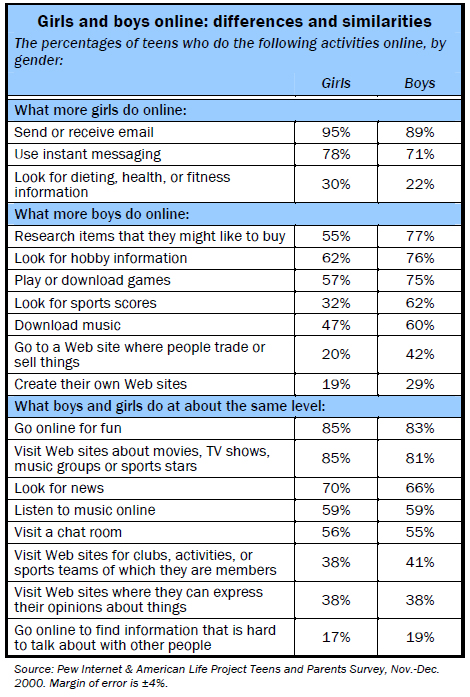
- Send and read email
Email is the most often-sampled feature of the Internet for youth, just as it is for adults. Fully 92% of online teens have used email. More girls (95%) report email use than boys (89%). The boys’ number is lower due to lesser enthusiasm for email among younger boys. Of online boys aged 12 through 14, 84% have used email at one time or another. New users are also a bit less enamored with email, as are youth from lower-income families (those in households earning less than $30,000) and families headed by parents without college educations.
- Browse for fun
The next most popular thing to do after email is to go online to pass the time for fun. Eighty-four percent of online youth say that they do this. Boys and girls are equally likely to report going online to pass the time. There is little variation among ages, either. Youth who live in households with only one parent are more likely than other teens to go online to pass the time, with 91% of these teens reporting doing this. A 17-year-old boy in the Greenfield Online group reports going online “and just looking for stuff that interests me at new sites.”
- Go to Web sites about movies, TV shows, music groups or sports stars
Like adult newbies, online youth enjoy searching for entertainment-related information. There is little difference overall between girls and boys on this front. However, older girls ages 15-17 are the most likely to have been to such sites, with 87% of them saying that they have done this at one time or another, compared to 80% of boys the same age and 83% of all online teens. “Each session online,” says a girl, 15, from the Greenfield Online group, “I check my email, check for hits to my page, and visit sites of my artist or athletes.”
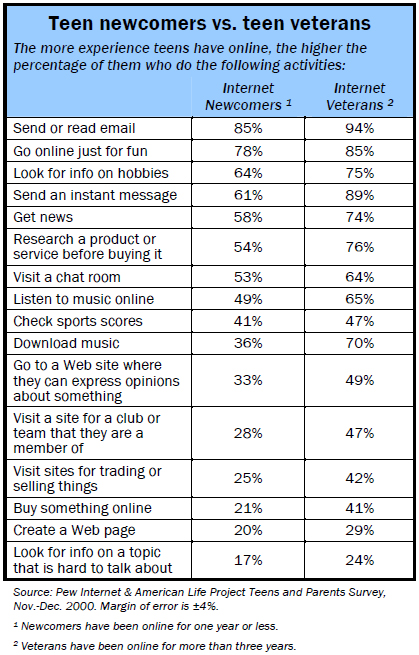
- Hobbies
Sixty-nine percent of online youth access Web sites related to favorite hobbies. This compares to the 78% of adults who search for hobby information. Boys are more likely to go to hobby Web sites than girls, with 76% of boys having ever done this, compared to 62% of girls.
Boys are also more likely than girls to feel that the Internet helps them with their hobbies. 59% of all boys believe that the Net helps them some or a lot with their hobbies, compared to 44% of girls who say that. One 17-year-old boy from the Greenfield group noted, “The Internet has been a great tool in finding information about paleoanthropology. I have read all the books I could find on this subject and taken college classes in high school in physical anthropology. I seem to always want to find more information on this and the Internet is the place to find it. There are numerous research institutions, universities and personal Web pages that people have graciously shared their information on.” Another 15-year-old boy in the group added: “I have a rather large basketball card collection, so eBay.com has given me an idea of what my stuff is worth.”
- News
[First, I]
- Online purchases and comparison-shopping
Some recent studies suggest that teens have hefty spending power – by some accounts teens receive $55 billion a year from their parents. Add in money that teens earn on their own, and the sum grows even larger.17 Still, while teens may have substantial purchasing power, their limited access to credit cards limits how many can buy online. Some 31% have purchased goods online, compared to 51% of online adults who have done so. More older teens with Internet access (36%) have done this than younger teens (26%).
But many more teens use the Internet to research their purchases. Two-thirds (66%) of teens research items online that they might like to buy. This gap between looking and buying is mirrored by adults – 75% of those 18 older and online have researched purchases, but 53% have actually made a purchase online.18 Boys are the most likely to research purchases online, with 77% of boys having searched online for product or service information, compared to 55% of girls. The oldest boys are the most likely to have sought such information.
[s]
Boys are much more likely to find the Internet useful for comparison-shopping and finding good deals. Forty-five percent of online boys say they find the Internet helps them “some” or “a lot” to get the best prices on the things they buy. Only 28% of girls report such positive feelings. In fact a full 50% of all girls say the Internet is not helpful at all for finding good prices on things they want to buy. Older youth are also more likely to say the Internet is helpful for comparison-shopping. Forty-one percent of teens 15 through 17 say it is useful compared to 32% of younger teens.
- Get insights into what’s “cool”
More than half (54%) of teens say that the Internet helps them find out what’s cool in fashion and music that they like. Younger girls, 12 to 14, are the most likely (64%) to say that the Internet helps them to find fashion and music. Fifty-nine percent of frequent users (those who go online every day) are also more likely to have used the Net to find out what’s cool. Youth from families earning less than $50,000 a year, single parent families and families with parents who went online a year ago or less are also more likely to say the Net helps them find what’s cool.
- Click on ads
Even as ad revenues drop in the current online climate, there is evidence that teens are receptive to online advertising. Youth do not seem to mind, but their parents do. Boys are much more likely to click on ads than girls. Sixty percent of boys report having clicked through, compared to 47% of online girls. Older youth are more likely than younger to have clicked on an ad; youth who log on every day are also more likely than less-frequent users to have clicked through on ads; and youth from wealthier families are more likely than those from households with lesser incomes to have checked out online ads.
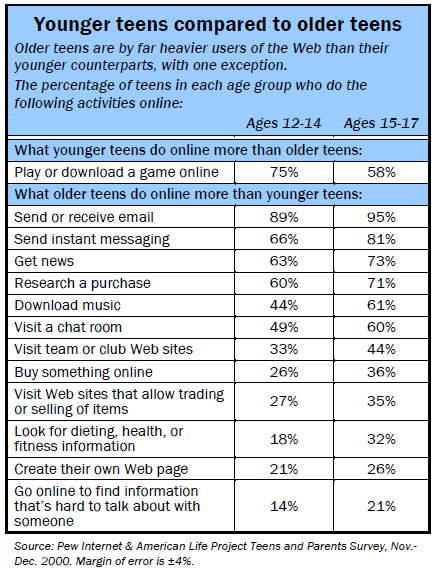
- Play or download online games
Two-thirds (66%) of teens have downloaded or played an online game. Younger teens are much more likely to have done this than older teens – three-quarters (75%) of teens 12 through 14 have played or downloaded games, compared to 58% of older teens. Boys also play more online games than girls – three-quarters of online boys have done this compared to 57% of all online girls. And younger boys (aged 12-14) are the most enthusiastic online games players. This contrasts with the adult online population, in which online game playing is generally more popular with women than with men.
- Music—everybody listens and boys do the downloading
Napster and other peer-to-peer file sharing systems like Gnutella and FreeNet have radically altered how teens learn about and get music. Teens have always been large consumers of music, and with their generally limited spending money have flocked to sites like Napster where they can learn about and download music for free. Consequently, listening to music and downloading music files from the Internet are very popular activities among teens, with 59% of online teens saying they listened to music online at one time or another and 53% saying they have downloaded music files. Boys and girls are equally as likely to listen to music online, but boys are much more likely to have downloaded music than girls, with 60% of boys reporting this, compared to 47% of all online girls. Older teens (61%) are also more likely to have downloaded music than younger teens (44%). And older boys (ages 15-17) are the most fervent music downloaders: Nearly three-quarters of them (73%) have downloaded songs.
- Chat rooms
Slightly more than half (55%) of all teens online said that they have visited a chat room. Boys and girls are equally likely to go to chat rooms. Older youth are far more likely to go to chat sites than 12 to 14 year olds (60% to 49%). Some youth say they prefer instant messaging to chatting because they feel it is easier to control conversational contacts and the flow of conversation itself. “When I’m with a group of people online, I will usually I.M them all separately,” said a boy, 16, in the Greenfield Online group discussion. “The reason being 1. it’s not a big jumble of people talking all at once (like talking in a crowd, where you hear everything that everyone has to say perfectly, hard to hear the person ur talking to.) [and] 2. setting up a chat room isn’t as easy as setting up several I.M.’s.” Many teens also told us about creating private chat rooms where they could control who was invited to participate. Says one girl, 14, in the Greenfield Online group discussion, “If there are a lot of people online, I set up a private chat room and invite my friends so we can all talk together.”
- Go to web page for clubs, groups or sports teams that you are a member of
A considerable number of these wired teens participate in extracurricular activities and organizations that have Web sites. These pages contain information about practice times, schedules, and games or events after they have taken place. Thirty-nine percent of all youth said they had visited these sites. Older youth of high school age are more likely to do this than younger – with 44% of 14 to 17 visiting team and club Web sites, compared to 30% of middle and junior high school-aged younger teens.
Much of the day to day organizing for these clubs or groups now occurs over email or instant messaging. “I am in the Drama Club at our school and in my last email I touched on the idea of next year’s play,” said one 16-year-old boy from the Greenfield Online group. “I want to try to get other people to pick out a production that’s good. Last year we did Hello Dolly! which was kinda dumb…” Added another girl 14 in the same group: “Just yesterday I was talking on IM with my best friend Laura. We are in the same religious youth group…and she is President and I am Vice President, so we were talking about upcoming events that we were planning and talking about events that have already taken place.”
- Trade or sell things
Auction and trading sites like eBay are increasingly popular among online teens. Boys are twice as likely to have gone to these sites than girls. Twenty percent of girls have been to trading or auction sites, compared to 42% of boys. Age also makes a difference – younger teens with Internet access are somewhat less likely than older teens (27% to 35%) to have visited auction or trading sites. And older boys (ages 15-17) are the most likely to have been to such sites. Nearly half (46%) report doing so.
- Look online for fitness, dieting or health information
Older girls are the most likely to look for this type of information – 40% of online girls 15 to 17 reported that they had done so. Older boys were the next most likely to search for that information with 26% saying they had visited those sites. Eighteen percent of all the younger (12-14) online teens said they had looked for health, fitness or dieting information. “I’m sure many teens (including myself) do this occasionally,” noted a girl, 15, in the Greenfield Online group discussion. “Health and body issues is the topic that sticks out in my mind when it comes to sensitive subjects that can be researched online.”
- Express yourself: Create your own Web page, give your opinion
One-quarter (24%) of all online teens have created their own Web pages. Older boys lead the pack with one third (34%) of them saying that they have designed their own page. Said one girl, 14, from the Greenfield Online group “My favorite thing to do online is check emails and update my Web page on [favorite TV show].”
Almost two-fifths (38%) of online teens have ever visited a Web site where they could express their opinions. There are no significant differences defined by age or gender in this activity. Teens who go online every day are enthusiastic about expressing themselves online, with 48% saying they visit sites where they can express their opinion about something, compared to 31% of teens who go online less often.
- Go online to get information about something that’s hard to talk about with other people
Eighteen percent of online youth said they have looked online for sensitive information and more than a quarter of all online teens (26%) think the Net is helpful in this regard. Older teens are more likely to have done this than younger (21% to 14%) and are slightly more likely than younger teens to say that the Internet is helpful for this purpose. Fully a quarter of older teenage boys (ages 15-17) say they have turned to the Internet to get information on sensitive subjects.
Children from families with modest incomes and whose parents do not have college educations are more likely to say that they think the Net helps to find information that is hard to talk about with others. “You may have noticed that I often note the website virtualkid.com,” wrote one 16-year-old boy from the Greenfield Online group discussion. “It was a website for teens complete with forums and information and just help in general for teenagers…. Besides dating, the site had information on puberty and all the awkward teenage moments. It was a really nice, helpful site.” Said another 17-year-old girl in the Greenfield group: “Yeah, I’ve done it before. It’s less weird and cheaper than going to a doctor to ask.”
“If I did need to find such information at a point in my life my first step would be looking online. It’s easier, more private, and faster,” added a 17-year-old boy in the same group. “Then if I could not find what I was looking for, I’d head to a library or see a professional. I figure that if you can solve a personal problem yourself, more power to you. Some issues that people might feel uncomfortable about could be health issues, sexuality issues, religious questions, or dating issues.”
Single-parent households are different from two-parent households
Twenty-eight percent of all American youth live in single parent households (or close to 20 million children).19 They are 17% of our sample and there are some differences between the online behaviors of youth in single parent households and those with two parents at home.
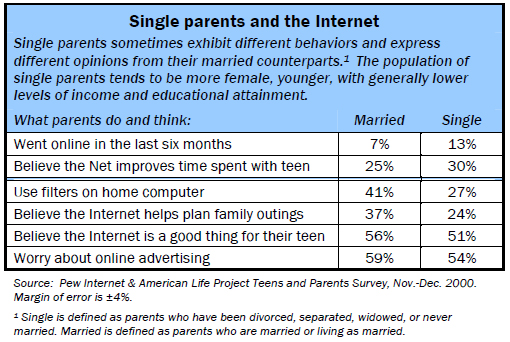
Youth living with one parent are more likely to go online just for fun (91%, compared to 83% of youth with two parents at home), visit chat rooms (61% to 54%), play or download games online (71% to 65%) and are more likely to research products they would like to buy online (71% to 65%). Youth with two parents at home are more likely to search for news online (70% to 61%) and buy something online (32% to 27%). Some of the differences might indicate that the computer is more of a babysitter and companion for youth with one parent. The differences between buying and researching products could be tied to the income levels in single-parent homes and to the greater likelihood that these households have just recently gotten Internet access.




